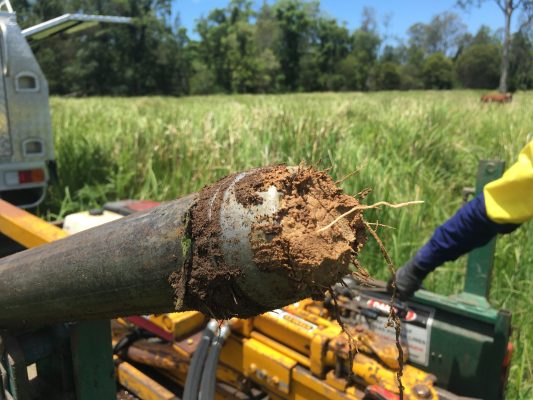How much carbon is stored in the soils of grazing paddocks across the Northern Rivers region? What factors influence these levels? And can land management practices increase productivity and soil health?
Southern Cross University researcher Dr Abe Gibson has been working with the Casino Food Co-op and Border Ranges Richmond Valley Landcare to find out.
The project
Dr Gibson and his team collected soil cores to 1m depth across 120 grazing paddocks. These were tested for soil carbon concentrations at 0-10cm, 10-30cm and 30-100cm depths. The 0-10cm samples were then also tested for soil fertility.
“We also compared soil carbon across the major soil types of the region. This approach leverages more information to identify trends relevant to individual farms,” he said.
Soil types and carbon levels
The complex geological history of the region and its subtropical climate has led to the formation of highly diverse soils. The lowest soil carbon levels were observed on sandier soils, down to less than 1%, while heavy, black clay soils had carbon levels up to 8% in the top 30cm.
Soil carbon levels were generally lower on hillslopes than floodplains. In flatter areas, eroded soil and moisture accumulate. These soils are usually deeper and more fertile as a result. They generally then produce greater pasture growth and so have higher carbon levels.
In the Northern Rivers, vertosols (cracking clay soils) are usually found on floodplains. They have high clay content and inherent fertility, and so were high carbon soils. Red ferrosols are found around the Lismore area. These also have high clay content and fertility but can bind soil organic matter, and prevent its degradation, due to their high iron content. These two soil types had the highest levels of carbon, followed by dermosols and kurosols that are found around Casino and to the west.


How deep does carbon go?
Soil carbon levels decreased with soil depth. Some paddocks registered levels up to 12% carbon in the 0-10cm layer, then as high as 6% in the 10-30cm layer. Soil carbon levels varied from 0.1 to 2% in the 30-100cm layer. However, when this is converted to a carbon stock, in tonnes of carbon per hectare, this deep carbon can account for 60% of the total carbon stored in the soil.
The spatial trends in deep carbon matched the top 30cm trends, with vertosols and ferrosols storing the most carbon. These deep levels tend to be driven by soil physical properties and parent material. However preliminary results indicate there is an association with vegetation.
How much influence management can have on deep carbon levels is still unclear, but it’s something SCU researcher Evanna McGuiness hopes to shed light on through another project.
Two interesting findings
In terms of management strategies, paddocks that had been under rotational management for more than five years had higher soil carbon. Resting pastures promotes above and belowground biomass production, leading to these higher levels.
“This is generally best practice in the Northern Rivers and carbon increases can be expected on decadal scales,” Dr Gibson said.
“However, there were two more interesting findings around management and soil carbon.
“Firstly, there were regional relationships between some soil micronutrients and carbon levels. Bioavailable copper and boron are two micronutrients that were correlated with soil carbon. These were considered deficient across most paddocks, which is a common effect of animal production. Copper and boron are important for plant growth, and so paddocks with higher levels may be producing more vegetation and so have higher soil carbon.
“Also, copper can act as a co-enzyme for soil microbes. Deficient levels may then impact the ability for microbe populations to grow or reduce the efficiency in which they form stable soil carbon.
“Secondly, we observed higher soil carbon levels in paddocks that utilised winter feed compared to paired paddocks that did not. These increases could be in the magnitude of 2-3% for the top 10cm and 1-2% for the 10-30cm layer. These soils also had higher levels of labile carbon and microbial biomass.
“Work by other organisations across the region has demonstrated the production benefits of this practice. Now, we have preliminary soil data to add environmental benefits too.
“These management trends were consistent across soil types.”
What’s next?
Currently, increasing soil copper and boron levels to improve pasture productivity and carbon storage is hypothetical, Dr Gibson said.
More work is needed to validate this under field conditions, and quantify expected increases in soil carbon.
For winter feed use, significantly increasing biomass appears to increase soil health. However, investing in this practice can be risky across our dry winters.
More work is needed to minimise risk and maximise production and soil benefits.
SCU, in partnership with many other groups, is actively seeking to investigate the role of micronutrients and winter feed in building soil carbon.